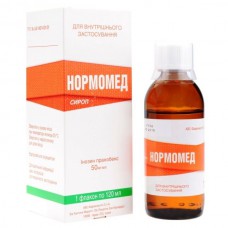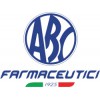Expiration date: 09/2026
Composition:
100 ml syrup contains active substance: Inosine pranobex 5.00 g
Auxiliary substance:
Sucrose 65,00 g
Glycerol 5.00 g
Methyl parahydroxybenzoate 0.18 g
Parahydroxybenzoate 0.02 g
Citrus flavor 0.50 g
Water purified to 100 ml
Description:
Transparent, slightly yellowish liquid with a characteristic odor.
Pharmacotherapeutic group:
Immunostimulating agent
Pharmacodynamics:
Immunostimulatory agent, with an antiviral effect. Is a complex containing inosine and salt of para-acetamidobenzoic acid with N,N-dimethylamino-2-propanolol in a molar ratio of 1:3.
The effectiveness of the complex is determined by the presence of inosine, the second component increases its accessibility to lymphocytes. Normaled blocks the multiplication of viral particles by damaging the genetic apparatus, stimulates the activity of macrophages, proliferation of lymphocytes and the formation of cytokines. The second component increases the availability of the drug Normaled for lymphocytes. Reduces the clinical manifestations of viral diseases, accelerates recovery, increases resistance of the organism.
In the appointment of Normaled as a secondary drug in infectious lesions of the mucous membranes and skin caused by the virus Herpes simplex, is a more rapid healing of the affected surface than in the treatment in the traditional way. Less often there are new bubbles, swelling, erosion and recurrence of the disease.
With the timely use of the drug reduces the frequency of viral infections, reduces the duration and severity of the disease.
Pharmacokinetics:
After oral administration, the drug is rapidly and almost completely (>90%) absorbed and has good bioavailability. When administered at a dose of 1500 mg Cmax of pranobex achieved through 1 h and is 600 µg/ml Not detected in the blood after 2 h after administration.
Narkomed consists of inosine and a salt of para-acetamidobenzoic acid with N,N-dimethylamino-2-propanolol. Each component of pranobex inosine is rapidly metabolized. Almost 100% of metabolites are found in urine in the range from 8 to 24 hours from the date of admission.
Inosine is metabolized in a cycle typical of purine nucleotides, to form uric acid, the concentration of which in the serum may increase. As a result, the formation of uric acid crystals in the urinary tract. The increase of uric acid concentration is not linear and may vary by ±10% within 1-3 h after taking the drug inside.
As a result of the metabolism of para-acetamidobenzoic acid,ortho-acylglucuronide is formed; N, N-dimethylamino-2-propanol is metabolized to n-oxide. AUC para-acetamidobenzoic acid >88%, AUC N,N-dimethylamino-2-propanol - >77%.
Cumulation of the drug in the body was not found. Inosine and its metabolites are excreted in the urine. Upon reaching the Css when receiving daily doses of 4 g daily urinary excretion of para-acetamidobenzoic acid and its metabolite is approximately 85% of the dose; T1/2 - 50 min, Tl/2N,N-dimethylamino-2-propanol for 3-5 hours Complete elimination of the pranobex and its metabolites from the body occurs within 48 hours.
Indications:
- Treatment of influenza and other respiratory;
- immunodeficiency conditions caused by viral infections in patients with normal and weakened immune systems, including diseases caused by Herpes simplex (type I and type II, genital herpes and herpes of other localization);
- subacute sclerosing panencephalitis.
Contraindications:
- Hypersensitivity to inosine pranobex and other components of the drug;
- gout;
- urolithiasis;
- chronic renal failure;
- arrhythmias;
- pregnancy;
- breastfeeding period;
- children's age up to 3 years (body weight up to 15-20 kg).
With caution: with simultaneous administration with xanthine oxidase inhibitors, diuretics, zidovudine; in acute liver failure
Pregnancy and lactation:
It is contraindicated for pregnant and breast-feeding women, because the safety of the drug has not been investigated.
Method of application and doses:
Inside, after eating, squeezed small amounts of water through equal time periods (8 or 6 h) 3-1 times a day.
Dosing regimen is set individually, depending on the age, body weight, as well as the severity of the disease.
Adults and children over 12 years of age: based on 50 mg per 1 kg of body weight, up to a maximum of 4 g per day. Usually appoint 20 ml of syrup 3-4 times a day.
Children from 3 to 12 years: 50 mg per 1 kg of body weight per day, divided into 3-4 admission.
Adults and children with severe infectious diseases the dose can be increased up to 100 mg/kg/day in 4-6 receptions. The maximum daily dose in adults is 3-4 g per day, in children-50 mg/kg / day.
In acute diseases: treatment usually lasts from 5 to 14 days. After the symptoms disappear, treatment should be continued for 1-2 days or more, depending on the indications.
In chronic recurrent diseases: treatment in adults and children is carried out courses lasting 5-10 days at intervals of 8 days. The duration of maintenance treatment can be up to 30 days, and the dose can be reduced to 500-1000 mg/day.
Treatment of herpes virus infections in adults and children: several courses should be conducted between 5 and 10 days before symptoms disappear.
Special groups of patients
Use in elderly patients. There is no need for dose correction, the drug is used in the same way as in middle-aged patients. In elderly patients, an increase in the concentration of uric acid in blood serum and urine is more common than in middle-aged patients.
Use in children. It is used in children older than 3 years.
Use in patients with renal and hepatic insufficiency. On the background of treatment with the drug should Normaled every 2 weeks to monitor the content of uric acid in serum and urine. Monitoring the activity of liver enzymes is recommended every 4 weeks with long courses of treatment with the drug.



